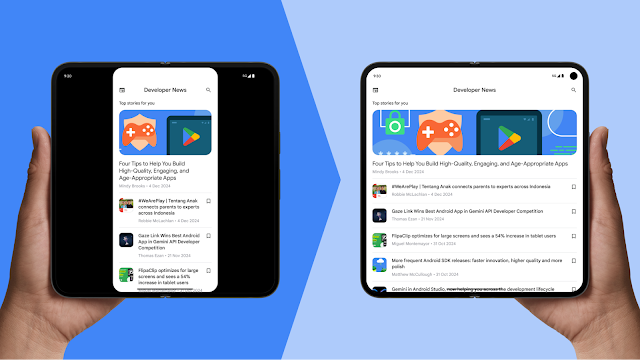Android 앱은 휴대전화, 태블릿, 폴더블, ChromeOS 기기, 자동차, TV, XR 등 모든 종류의 기기에서 실행됩니다. 이러한 다양한 환경에 적응하려면 앱이 모든 기기 폼 팩터와 디스플레이 크기를 지원해야 합니다.
Android 16 (API 수준 36)에서는 화면 방향, 가로세로 비율, 크기 조절 가능성에 관한 앱 제한을 재정의하여 앱이 다양한 폼 팩터와 디스플레이 크기에 적응할 수 있습니다. 재정의는 최소 너비가 600dp 이상인 기기에 적용되며 다음을 정의합니다.
- 태블릿
- 대형 화면 폴더블의 내부 디스플레이
- 데스크톱 창 모드 (모든 폼 팩터)
API 수준 36을 타겟팅하는 앱은 디스플레이의 최소 너비가 600dp 이상인 경우 크기를 조절할 수 있고 멀티 윈도우 모드 (resizeableActivity="true"과 동일)로 전환할 수 있습니다.

Android 16에서는 기기 방향, 화면 비율, 디스플레이 크기에 관한 사용자 환경을 존중하여 사용자 환경을 최적화하는 일관된 적응형 앱 디자인 모델을 적용합니다.
변경사항
큰 화면에서 Android 16 (API 수준 36)을 타겟팅하는 앱의 경우 다음 매니페스트 속성과 API가 무시됩니다.
| 속성 또는 API | 무시된 값 |
|---|---|
screenOrientation |
portrait, landscape, reversePortrait, reverseLandscape, sensorPortrait, sensorLandscape, userPortrait, userLandscape |
resizeableActivity |
모두 |
minAspectRatio |
모두 |
maxAspectRatio |
모두 |
setRequestedOrientation()getRequestedOrientation() |
portrait, landscape, reversePortrait, reverseLandscape, sensorPortrait, sensorLandscape, userPortrait, userLandscape |
예외
Android 16 변경사항의 예외는 다음과 같습니다.
sw600dp보다 작은 디스플레이 (대부분의 휴대전화, 플립형, 대형 화면 폴더블의 외부 디스플레이)
android:appCategory플래그를 기반으로 하는 게임Android App Bundle 및 Play 앱 서명을 사용하여 게임을 게시하면 Google Play에서 플래그를 관리하고 App Bundle의 이점을 자동으로 제공할 수 있습니다. 앱 매니페스트 개요도 참고하세요.
사용자가 가로세로 비율 설정에서 앱의 기본 동작을 선택함
선택 해제
API 수준 36 동작을 선택 해제하려면 PROPERTY_COMPAT_ALLOW_RESTRICTED_RESIZABILITY 매니페스트 속성을 선언합니다.
특정 활동을 선택 해제하려면 <activity> 요소에서 속성을 설정합니다.
<activity ...>
<property
android:name="android.window.PROPERTY_COMPAT_ALLOW_RESTRICTED_RESIZABILITY"
android:value="true" />
...
</activity>
앱 전체에서 선택 해제하려면 <application> 요소에서 속성을 설정합니다.
<application ...>
<property
android:name="android.window.PROPERTY_COMPAT_ALLOW_RESTRICTED_RESIZABILITY"
android:value="true" />
...
</application>
테스트
앱이 Android 16 변경사항의 영향을 받는지 테스트하려면 Android 스튜디오에서 Pixel Tablet 및 Pixel Fold 시리즈 에뮬레이터를 사용하고 앱의 모듈 build.gradle 파일에서 targetSdkPreview = "Baklava"를 설정하세요.
또는 UNIVERSAL_RESIZABLE_BY_DEFAULT 플래그를 사용 설정하여 테스트 기기에서 앱 호환성 프레임워크를 사용합니다 (호환성 프레임워크 도구 참고).
Espresso 테스트 프레임워크와 Jetpack Compose 테스트 API를 사용하여 테스트를 자동화할 수 있습니다.
일반적인 문제
기기 방향, 가로세로 비율 또는 앱 크기 조절 가능 여부를 제한하는 앱은 Android 16에서 레이아웃이 겹치는 등 디스플레이 문제가 발생할 수 있습니다.
휴대전화, 폴더블, 태블릿, ChromeOS 기기, 자동차 디스플레이, XR에서 최적의 사용자 환경을 제공하려면 반응형 및 적응형으로 앱을 빌드하세요.
늘어난 UI 구성요소 방지: 표준 세로형 휴대전화 화면용으로 설계된 레이아웃은 다른 화면 비율을 수용하지 못할 수 있습니다. 예를 들어 디스플레이의 전체 너비를 채우는 UI 요소는 가로 방향에서 늘어난 것처럼 표시됩니다. 늘어남을 방지하기 위해 구성요소에 최대 너비를 추가합니다.
레이아웃 스크롤 사용 설정: 레이아웃이 스크롤되지 않으면 사용자가 가로 방향에서 화면에 표시되지 않는 버튼이나 기타 UI 요소에 액세스하지 못할 수 있습니다. 앱 레이아웃을 스크롤하여 디스플레이 높이와 관계없이 모든 콘텐츠에 도달할 수 있는지 확인합니다.
세로 모드와 가로 모드에서 카메라 호환성 확인: 카메라 센서와 관련된 특정 가로세로 비율과 방향을 가정하는 카메라 뷰파인더 미리보기는 비규격 디스플레이에서 늘어나거나 뒤집힌 미리보기를 초래할 수 있습니다. 뷰파인더가 방향 변경에 따라 올바르게 회전하는지 확인합니다. 뷰파인더가 센서 가로세로 비율과 다른 UI 가로세로 비율에 맞게 조정되도록 지원
창 크기 변경 시 상태 유지: 방향 및 가로세로 비율 제한이 삭제되면 사용자가 앱을 사용하는 방식에 따라 앱 창 크기가 자주 변경될 수 있습니다. 예를 들어 기기를 회전하거나 접거나 펼치거나 멀티 윈도우 또는 데스크톱 창 모드에서 앱 크기를 조절하는 경우입니다. 방향 변경 및 창 크기 조절과 같은 구성 변경으로 인해 활동이 다시 생성됩니다 (기본값). 최적의 사용자 환경을 제공하려면 구성 변경 중에 앱 상태를 유지하여 앱이 데이터 (예: 양식 입력)를 유지하고 사용자가 컨텍스트를 유지할 수 있도록 하세요.
창 크기 클래스 사용: 기기별 맞춤설정 없이 다양한 창 크기와 가로세로 비율을 지원합니다. 창 크기가 자주 변경된다고 가정합니다. 창 크기 클래스를 사용하여 창 크기를 특성화한 다음 적절한 적응형 레이아웃을 적용합니다.
반응형 레이아웃 빌드: 창 크기 클래스 내에서 반응형 레이아웃은 디스플레이 크기 변화에 맞게 조정되어 항상 최적의 앱 프레젠테이션을 만듭니다.
타임라인
- Android 16 (2025): 모든 방향과 가로세로 비율, 앱 크기 조절 지원은 API 수준 36을 타겟팅하는 앱의 대형 화면 기기(최소 화면 너비 >= 600dp)를 위한 기준 환경입니다. 하지만 개발자는 선택 해제할 수 있습니다.
| 대상 API 수준 | 적용 가능한 기기 | 개발자 선택 해제 허용됨 |
|---|---|---|
| 36 (Android 16) | 대형 화면 기기 (가장 작은 화면 너비 >= 600dp) | 예 |
특정 API 수준 타겟팅 기한은 앱 스토어마다 다릅니다. 2026년 8월부터 Google Play에서는 앱이 API 수준 36을 타겟팅하도록 요구합니다.

